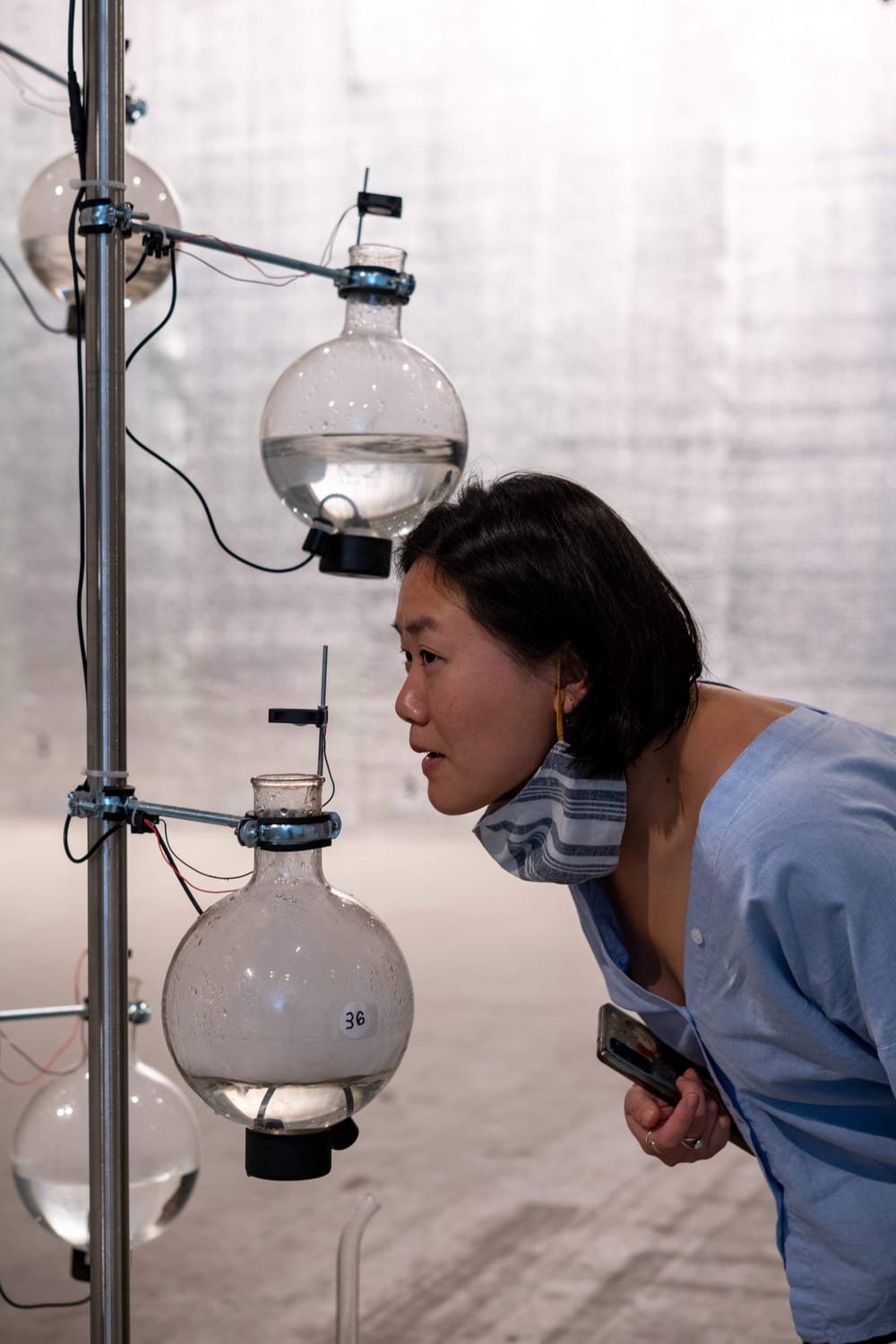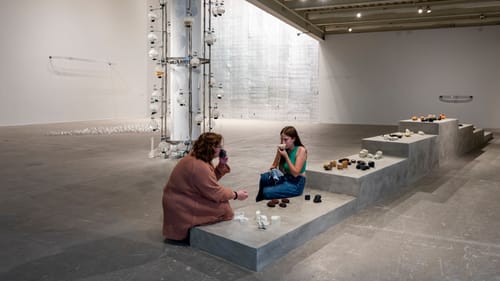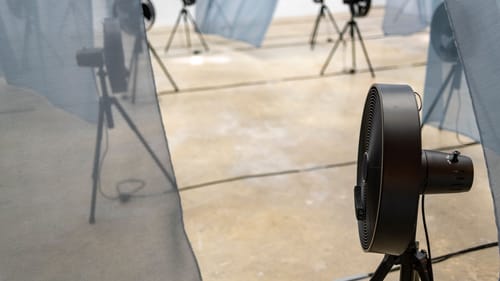Stay in the Loop
BSR publishes on a weekly schedule, with an email newsletter every Wednesday and Thursday morning. There’s no paywall, and subscribing is always free.
Follow your nose
The Institute of Contemporary Art presents Sissel Tolaas: RE_____

On the way to the Institute of Contemporary Art, I passed Monell Chemical Senses Center, where the great golden nose of the sculpture Face Fragment inhales Market Street. It was the perfect preparation for Sissel Tolaas’s RE_____. Tolaas, a Norwegian researcher and artist, has spent her career studying the sense of smell, and ICA is hosting the largest-ever exhibition of her work.
With a doctorate in organic chemistry, Tolaas devises participatory works around invisible stimuli we experience, continuously and often, unconsciously—wafting into our noses on each of the 24,000 breaths we take every day. The works, or as she calls them, “situations,” direct attention to the composition and perception of odors, forcing us to notice how they affect thought, emotion, and memory.
Tolaas says technology enables her to “break up a real smell into individual molecules and compounds, and then reconstruct it as close to the original as possible. My data base and lab consist of up to 10,000 molecules that I have built up over the last 25 years.”
The exhibit title implies the capacity of a smell to make a person REmember, REveal, REvive, and so on. Yet for all this power, the sense of smell receives scant attention, particularly in art.
This is the second iteration of RE_____, and for it, Tolaas reconfigured both her art and the ICA building. “Having the carte blanche to explore the building and taking down walls and revealing just the beauty of the building and the roughness of the building was fantastic,” she noted. The site-specific presentation was organized with ICA director Zoë Ryan. RE_____’s original version was organized at Oslo’s Astrup Fearnley Museum and was curated by Solveig Øvstebø.
The smell of exploitation?
The ICA’s first-floor gallery, stripped down and wide open, feels like a new-age laboratory dominated by industrial piping and glass beakers. A hieroglyphic of lines and numbers covers one wall, a cryptic key to the exhibition. Occasional hand and nose drawings on surfaces indicate where visitors should sniff or touch. Those hints, along with an introductory video, are the only information provided until the final gallery. Take a deep breath and proceed: you’re on your own.
Three silvery pipes descend from the ceiling, ending just above three doughnut-shaped ridges that form a triangular space where a nose reminds you to inhale. This is van-NIHL-uhhhhh (2022). The pipes exude three forms of vanilla, said to be the world’s favorite scent across cultures. Other pipes that wind through the exhibition carry the smell of money, from the work Liquid Money_1 (Ampoules), symbolizing a historical connection. Vanilla is largely grown in less-developed places, including African nations, and like other desirable resources, has been a focal point for exploitation by wealthier, more developed countries.
As visitors leave, they receive a tiny vial with the liquid scent of $380,000, which smells better than what’s in your wallet, but isn’t a fragrance to wear on a pulse point.
Molecules of memory
A two-story tree of numbered, globular beakers holds bubbling, smoking, and still liquids, SYMBIOTIC AGREEMENT AL_earth_22 (2019, 2021, 2022) stands at the center of the gallery. Each beaker wears a tiny fan around its neck, propelling the aroma of its contents into the air. Inhale at random: #36 is herbal; #18 is lighter, piney; and #13 is unscented but noticeably cool.

Move to the stepped platform to inspect EI_AI Emotional and Anthropological Intelligence (2012-2022) and find groups of feather-light objects that fit in the hand. Pick them up, rub them, sniff them. I could discern a smell only from the dark, pumice-like ovals with silver, dated tags—one was spicy, another reminded me of sandalwood. These pieces, I learned later, are imbued with the odor of volcanoes; the tags indicate eruption dates.
What about the other objects? I began to doubt the acuity of my nose, having already removed my customary mask. I imagined how fascinating it would be to follow a super smeller, or a dog, through the exhibit. (Note that, though the ICA continues to encourage masks, wearing one makes it almost impossible to experience RE_____.)
High anxiety, calm breeze
Continuing up a ramp to the second floor, walls are painted in completely unremarkable shades of white, but the eye deceives. Scratch and sniff to discover Fear 22/22 (2002 – ongoing), for which Tolaas imbued the paint with the replicated smell of “anxious and paranoid men.” In one place, I smelled vomit; in another, nail polish remover. Are manicures a coping mechanism for stress?
The dominant work on the second floor involves 10 theater-sized curtains billowing with the power of 20 fans, AirREborn BelowAbove (various years, 1994-2022). The fans are digitally linked to Norwegian weather stations measuring gales over the Norwegian Sea. When I visited, the sheer, blue-gray fabric swelled placidly, indicating calm winds on Norway’s west coast. There was no noticeable smell of the sea.

The final gallery offers take-away information on the “situations,” but it’s not especially helpful, for the most part offering word clouds and stream-of-consciousness-style text. If your nose is perceptive, you may not want more information. If not, what’s here won’t help.
Rhonda and Linda to the rescue
Speaking for the olfactorially challenged, I was fortunate to run into Rhonda and Linda, the most engaging museum guards I’ve ever encountered. After watching over the exhibit for two months, they know Tolaas’s work better than anyone except the artist herself, and they wouldn’t let me miss a thing. When I wasn’t close enough, or low enough, or looked confused, they rescued me.
Rhonda said she enjoyed telling people to move closer and touch things for a change and indicated that a collection of glass globes on the floor, Still_A_Life (2020, 2021, 2022), were blown by Tolaas over 365 days and contain the artist’s breath. After I’d made the circuit and was preparing to leave, Linda learned that I’d missed some things and walked me back to them, narrating all the way.
Given Tolaas’s deliberate reticence about the work, was it cheating to accept help, rather than relying solely on my own impressions? Maybe, but I inhaled every tidbit. Without Rhonda and Linda, I’d have been far more confused and had far less fun.
What, When, Where
Sissel Tolaas: RE_____. Through December 30, 2022, at Institute of Contemporary Art, University of Pennsylvania, 118 South 36th Street, Philadelphia. The gallery is free and open to the public. (215) 898-7108 or icaphila.org.
Accessibility
ICA strongly encourages the use of face masks. Hand sanitizer stations are provided throughout the building. For additional information or questions, please contact Visitor Services Coordinator Elizabeth Chong at (215) 898-7108 or check the gallery website.
All public spaces at ICA are accessible by elevator. Accessible restrooms are located on the first floor. Service animals are welcome. Manual wheelchairs are available on request, and gallery stools are provided. Large-print gallery guides are available as well. For complete information and questions, visit ICA’s accessibility page.
Sign up for our newsletter
All of the week's new articles, all in one place. Sign up for the free weekly BSR newsletters, and don't miss a conversation.
